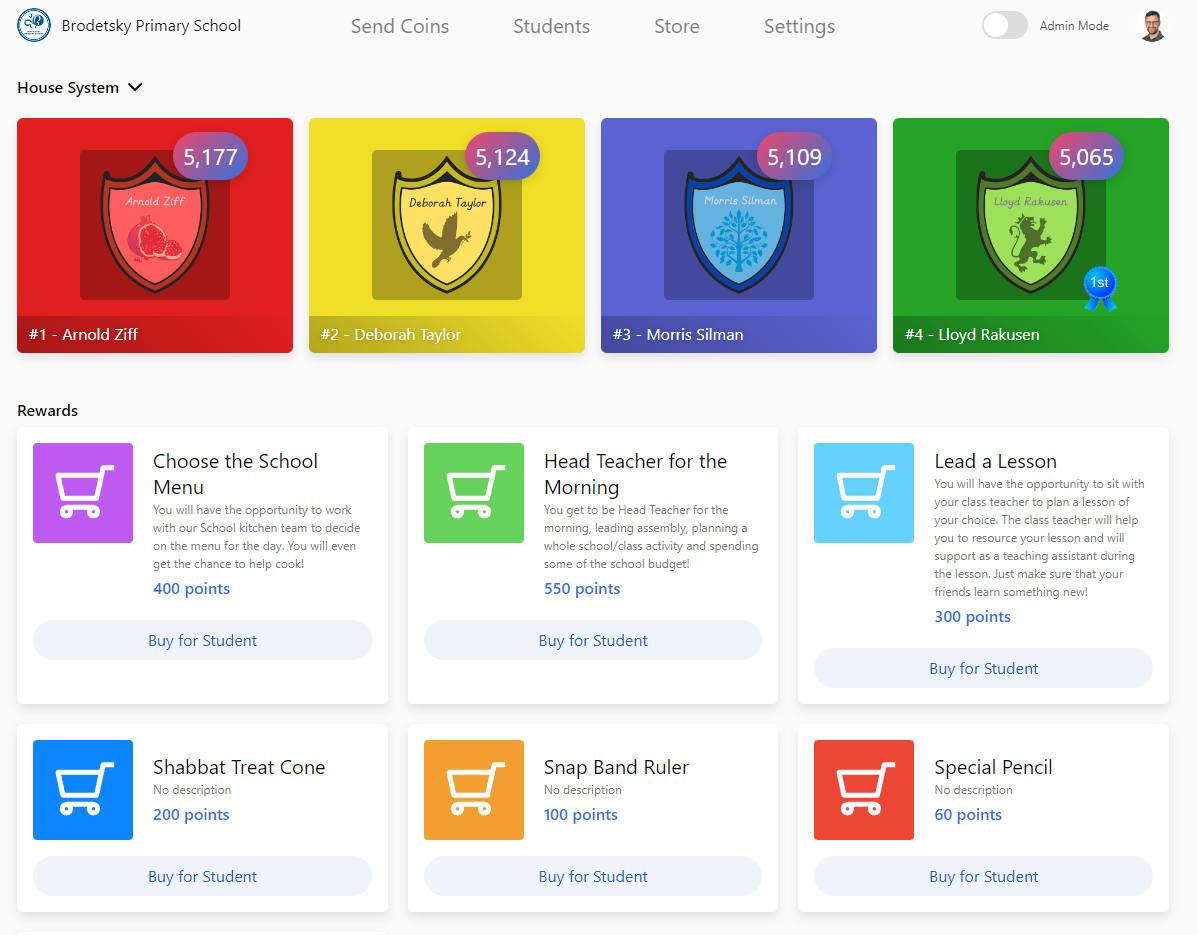
At Brodetsky Primary School in Leeds, England, we serve students ages 2 through 11 years old and have used a house system for 40 years. A house system — which some of you may remember was used in the Harry Potter series — provides a sense of community and offers points for accomplishments, good behavior and other things. For most of that time, we managed it on paper in our main hall, which was a logistical nightmare. Every Friday, teachers would have to add up the weekly totals for their own classroom, which often took a half hour or more, and then we’d have to update the main board manually. We loved using the houses, but administering them was a huge waste of time. A digital house system made much more sense.
Recently, we switched to CritterCoin, a digital platform that makes managing the Houses much easier. We also found that the new platform helps us reach beyond campus to better engage not just our students but their families as well. Here’s how it works.
Earning points for yourself and your house
We are a Jewish school, and more than 95% of our students are Jewish, so we decided to name the houses after prominent local Jewish philanthropists in our city. One is named for Arnold Ziff, a gentleman who paid for a wing in one of the city’s hospitals as well as doing other good work. Another is named after Deborah Taylor, who supported the building of our on-site preschool. We hope these and other names instill a bit of pride in our students’ heritage by celebrating the good work others have done in our community.
When a student is awarded a point — now a digital coin — they receive it as an individual, but their house also receives the coin for the schoolwide house competition. Students can win coins for themselves and their houses by displaying a variety of positive behaviors. They can get a coin each day for reading at home. They can earn coins for being a mensch, which means going out of their way to help others. Our core values as a school are creativity, resilience and independence, because we think that creative, resilient and independent students are good learners — so students can win coins for behaviors that exemplify those characteristics.
The coins also have different point values attached to them. The school value-oriented coins, such as creativity, independence or resilience, are worth two points each. Being awarded a mensch coin wins three points for both the individual student and their house. Teachers can hand out any of these coins, but we also have a deputy headteacher’s coin that is worth five points and an executive headteacher’s coin worth 10 points that can only be given out by the senior leaders of the school.
During assemblies, we sometimes hold house competitions, which might be a contest in math, singing, geography, dancing or any number of things. For a dance contest, entire houses might all participate, while for a spelling contest, each house might nominate a champion to compete on their behalf. But the competition doesn’t end when school does. Students can also earn coins at home.
Digital house system connects families, students and school
The digital house system we use has a feature called Dailies that allows us to give students’ families a coin to award their children each day. For example, we ask guardians to disburse read-at-home coins when they read with their children at home.
We can see when each coin was awarded to individual students, and we can see which caretakers are giving out coins and which are not, which in turn gives us some insight into what students are being read to at home. That allows us to focus more on those students who aren’t getting the home help or to go to those families to see how we can help them begin reading with their children.
Offering experiences as rewards
At the end of each term — at Hanukkah, Passover and beginning of summer — we add up the total points for each house and treat the winner. We like to award experiences rather than stuff to the house winners, so they might get a movie day or a day where they can wear their own clothes to school instead of their uniform. Whether on the school website or on their phones and tablets at home, they can always see which house is in the lead at the moment, so there’s a bit of a horse-race aspect to it that helps keep them competitive and engaged.
For their individual rewards, students get to choose when they get their rewards. They can buy a pencil, for example, for 60 points. Or they can save up their points until they reach 600 and cash them all in to be a teacher for a day. When we used the old paper system to track their points, they’d have to wait until the end of the term to cash in and get their prize, but now they can keep track themselves regularly and decide if they want a small prize now or want to work toward something more exciting.
Keeping parents involved and excited
This is our first year using this digital platform, but so far the reception from families has been great. A few weeks after school began and after students began using the new digital house system, we held a curriculum night where we also introduced the new platform to students’ families. They were all talking about how exciting it was, and they particularly liked the fact that their children had to choose between the instant gratification of a small prize now and the self-discipline required to save up for a more rewarding prize. In that way it works just like real money and provides a fun opportunity for students to practice a key life skill.
I’m the one who sends out the daily read-at-home coins. If the emails I receive asking where it is if I’m a few minutes late are any indication, enthusiasm from families is still very high.
Since we switched to a digital house system, we’ve seen so much more engagement with caretakers. They like to know what their children are being rewarded for. The children receive their coins at the exact moment they are demonstrating desirable behaviors, and their families can see what they’re working toward.
Sagi Yechezkel is deputy head teacher at Brodetsky Primary School in Leeds, England, where they use CritterCoin to manage their digital house system. Yechezkel can be reached at [email protected].
Opinions expressed by SmartBrief contributors are their own.
_________________________
Subscribe to SmartBrief’s FREE email newsletter to see the latest hot topics on EdTech. It’s among SmartBrief’s more than 250 industry-focused newsletters.
